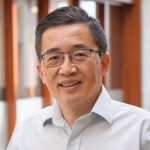
-
Research Editor-in-Chief “Gezhi” International Forum——The 3rd Anniversary Academic Report
2021-09-04
Organizer: Science and Technology Review
Topic: Flexible Electronics: Today and Future
Time: September 5, 2021 (Sunday) 9:30 AM - 12:30 PM (Beijing Time)
Content: online expert report and discussion, audience question and answer
Language: The speaker speaks Chinese or English, with two channels in Chinese and English, simultaneous interpretation
Chairpersons: Huang Wei, Cui Tianhong
Host: Wang Jianpu
Main audience: researchers in the field of flexible electronics, researchers in materials related fields, interested researchers and the general public
Live broadcast:
https://www.youtube.com/channel/UCqJZ2YOjMUps-NE3rS35KPQ
https://www.facebook.com/researchcloud.yun.7
Agenda
1. Introduce guests and speakers
2. Speech by Editor-in-Chief Huang Wei (China)
3. Speech by Bill Moran, the publisher of Science Series Journals
4. Speech by Editor-in-chief Cui Tianhong (International) and introduction of journal Research
5. Academic reports (50 minutes for each report, 5 minutes for answering questions)
1. "Ionic liquid perovskite photovoltaic cell": Chen Yonghua, Professor, Nanjing University of Technology
2. "Skin-inspired organic electronics": Zhenan Bao, Professor of Stanford University, Member of the National Academy of Engineering, Member of the American Academy of Arts and Sciences
3. "Modeling Programmable Drug Delivery in Bioelectronics with Electrochemical Actuation": Huang Yonggang, Professor of Northwestern University, Academician of the National Academy of Sciences, Academician of the National Academy of Engineering, Academician of the American Academy of Arts and Sciences, Academician of the European Academy of Sciences, Foreign Academician of the Chinese Academy of Sciences
Ionic liquid perovskite photovoltaic cell
Yonghua Chen is currently a full professor at Institute of Advanced Materials at Nanjing Tech University. He has got the Young 1000 Talents, Jiangsu Specially-Appointed Professor, Jiangsu Distinguished Young Scholars projects, and Jiangsu Province six talent peak projects. He has been focusing on perovskite photovoltaic cells in view of its efficiency and stability by taking ionic liquids as the main research line. The main representative results are as follows: 1) He has conceived and fabricated perovskite thin films based on environmentally-friendly ionic liquids instead of traditional commonly used toxic aprotic polar solvents, achieving highly efficient and stable perovskite solar cells. 2) He has proposed a new chemical control strategy for precursor solution, which stabilizes the layered perovskite framework and builds phase-pure layered perovskites. Highly efficient and stable two-dimensional layered perovskite photovoltaic cells were achieved. 3) A new method of ion channel reaction is proposed, stabilizing perovskite formation at room temperature and high humidity and achieving high efficiency and long-term stability. In last 5 years, as a correspondence author, he has published 50 papers (including Science, Nature Energy, Nature Photonics, Chem, Advanced Materials, Nano Letters, Angewandte Chemie International Edition, etc)
Abstract
Solvent is vital to control crystallization and crystal growth of the state-of-the-art solution-processed hybrid organic-inorganic perovskites. However, researchers just focus on the highly toxic and coordinating solvents (e.g., dimethylformamide, dimethylsulfoxide, and g-butyrolactone) and the based modification (e.g., antisolvent), which may hinder the success of perovskite solar cells (PSCs) in practical applications, and a largely serious unexplored challenge remains until now. Here, we report an alternative environment-friendly ionic liquid as a novel solvent for facile fabrication of PSCs in ambient air. Ionic liquid has excellent chemical properties with high viscosity, negligibly vapor pressure, and nonhazardous. Completely soluble of both ammonium and lead salts by hydrogen bonds in ionic liquid were observed. Dense and pinhole-free perovskite films with high reproducibility can be readily prepared by simple one-step method without anti-solvent even under the relative humidity over 80%. The findings may open up a new approach for further improving PSCs performance with higher reproducibility and reliability in ambient atmosphere.Skin-inspired organic electronics
K.K. Lee Professor and Department Chair in the Department of Chemical Engineering
Courtesy Professor in the Department of Chemistry and Department of Materials Science and Engineering
Stanford University
Director of Stanford Wearable Electronics Initiative (eWEAR)
Email: zbao@stanford.edu
Website: http://baogroup.stanford.eduZhenan Bao is Department Chair and K.K. Lee Professor of Chemical Engineering, and by courtesy, a Professor of Chemistry and a Professor of Material Science and Engineering at Stanford University. Bao founded the Stanford Wearable Electronics Initiate (eWEAR) in 2016 and serves as the faculty director.
Prior to joining Stanford in 2004, she was a Distinguished Member of Technical Staff in Bell Labs, Lucent Technologies from 1995-2004. She received her Ph.D in Chemistry from the University of Chicago in 1995. She has over 600 refereed publications and over 100 US patents with a Google Scholar H-Index >175.
Bao is a member of the National Academy of Engineering, the American Academy of Arts and Sciences and the National Academy of Inventors. She is a Fellow of MRS, ACS, AAAS, SPIE, ACS PMSE and ACS POLY.
Bao was selected as Nature’s Ten people in 2015 as a “Master of Materials” for her work on artificial electronic skin. She was awarded the MRS Mid-Career Award in 2021, the inaugural ACS Central Science Disruptor and Innovator Prize in 2020, the Gibbs Medal by the Chicago session of ACS in 2020, the Wilhelm Exner Medal by Austrian Federal Minister of Science 2018, ACS Award on Applied Polymer Science 2017, the L'Oréal-UNESCO For Women in Science Award in the Physical Sciences 2017, the AICHE Andreas Acrivos Award for Professional Progress in Chemical Engineering in 2014, ACS Carl Marvel Creative Polymer Chemistry Award in 2013, ACS Cope Scholar Award in 2011, the Royal Society of Chemistry Beilby Medal and Prize in 2009, the IUPAC Creativity in Applied Polymer Science Prize in 2008.
Bao is a co-founder and on the Board of Directors for C3 Nano and PyrAmes, both are silicon-valley venture funded start-ups. She serves as an advising Partner for Fusion Venture Capital.Abstract
Skin is the body’s largest organ, and is responsible for the transduction of a vast amount of information. This conformable, stretchable, self-healable and biodegradable material simultaneously collects signals from external stimuli that translate into information such as pressure, pain, and temperature. The development of electronic materials, inspired by the complexity of this organ is a tremendous, unrealized materials challenge. However, the advent of organic-based electronic materials may offer a potential solution to this longstanding problem. Over the past decade, we have developed materials design concepts to add skin-like functions to organic electronic materials without compromising their electronic properties. These new materials and new devices enabled arrange of new applications in medical devices, robotics and wearable electronics. In this talk, I will discuss basic material design concepts for realizing stretchable, self-healable and biodegradable conductive or semiconductive materials. I will show our methods for scalable fabrication of stretchable electronic circuit blocks. Finally, I will show a few examples of applications we are pursuing uniquely enabled by skin-like organic electronics when interfacing with biological systems, such as low-voltage electrical stimulation, high-resolution large area electrophysiology, “morphing electronics” that grows with biological system and genetically targeted chemical assembly - GTCA.
Modeling Programmable Drug Delivery in Bioelectron
Yonggang Huang is the Jan and Marcia Achenbach Professor of Mechanical Engineering at Northwestern University. He is interested in mechanics of stretchable and flexible electronics, and mechanically guided deterministic 3D assembly. He is a member of the US National Academy of Engineering, US National Academy of Sciences, a fellow of American Academy of Arts and Sciences, and a foreign member of the Chinese Academy of Sciences. He is a Highly Cited Researcher in Engineering (2009), in Materials Science (since 2014), and in Physics (2018). His research awards in the last 5 years include the Nadai Medal (2016), Thurston Lecture Award (2019), and Honorary Membership (2021) from the American Society of Mechanical Engineers; Prager Medal (2017) from the Society of Engineering Sciences; and Bazant Medal (2018) and von Karman Medal (2019) from the American Society of Civil Engineers. His recognitions for undergraduate teaching and advising in the last 5 years include the Cole-Higgins Award for Excellence in Teaching, McCormick School of Engineering, Northwestern University (2016), and on the Associated Student Government Faculty and Administrator Honor Roll, Northwestern University (2018, 2020).
Abstract
Drug delivery systems featuring electrochemical actuation represent an emerging class of biomedical technology with programmable volume/flowrate capabilities for localized delivery. Recent work establishes applications in neuroscience experiments involving small animals in the context of pharmacological response. However, for programmable delivery, the available flowrate control and delivery time models fail to consider key variables of the drug delivery system––microfluidic resistance and membrane stiffness. Here we establish an analytical model that accounts for the missing variables and provides a scalable understanding of each variable influence in the physics of delivery process (i.e., maximum flowrate, delivery time). This analytical model accounts for the key parameters––initial environmental pressure, microfluidic resistance, flexible membrane, current, and temperature––to control the delivery and bypasses numerical simulations allowing faster system optimization for different in vivo experiments. We show that the delivery process is controlled by two nondimensional parameters, and the volume/flowrate results from the proposed analytical model agree with the numerical results and experiments. These results have relevance to the many emerging applications of programmable delivery in clinical studies within the neuroscience and broader biomedical communities.
Tag: Research Academic News


